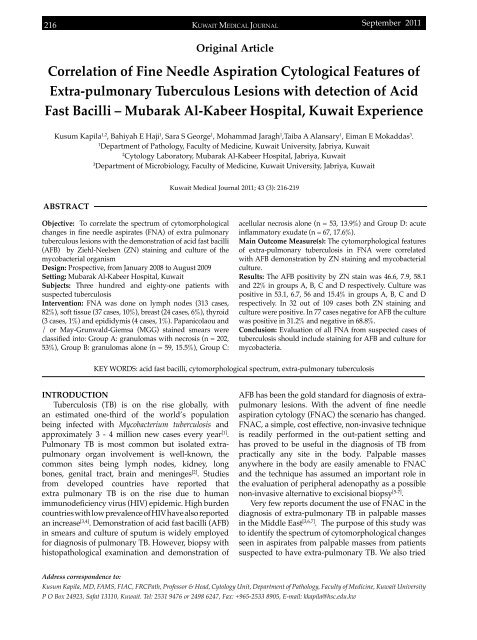Vol 43 # 3 September 2011 - Kma.org.kw
Vol 43 # 3 September 2011 - Kma.org.kw
Vol 43 # 3 September 2011 - Kma.org.kw
Create successful ePaper yourself
Turn your PDF publications into a flip-book with our unique Google optimized e-Paper software.
216<br />
KUWAIT MEDICAL JOURNAL<br />
<strong>September</strong> <strong>2011</strong><br />
Original Article<br />
Correlation of Fine Needle Aspiration Cytological Features of<br />
Extra-pulmonary Tuberculous Lesions with detection of Acid<br />
Fast Bacilli – Mubarak Al-Kabeer Hospital, Kuwait Experience<br />
Kusum Kapila 1,2 , Bahiyah E Haji 1 , Sara S Ge<strong>org</strong>e 1 , Mohammad Jaragh 1 ,Taiba A Alansary 1 , Eiman E Mokaddas 3 .<br />
1<br />
Department of Pathology, Faculty of Medicine, Kuwait University, Jabriya, Kuwait<br />
2<br />
Cytology Laboratory, Mubarak Al-Kabeer Hospital, Jabriya, Kuwait<br />
3<br />
Department of Microbiology, Faculty of Medicine, Kuwait University, Jabriya, Kuwait<br />
Kuwait Medical Journal <strong>2011</strong>; <strong>43</strong> (3): 216-219<br />
ABSTRACT<br />
Objective: To correlate the spectrum of cytomorphological<br />
changes in fine needle aspirates (FNA) of extra pulmonary<br />
tuberculous lesions with the demonstration of acid fast bacilli<br />
(AFB) by Ziehl-Neelsen (ZN) staining and culture of the<br />
mycobacterial <strong>org</strong>anism<br />
Design: Prospective, from January 2008 to August 2009<br />
Setting: Mubarak Al-Kabeer Hospital, Kuwait<br />
Subjects: Three hundred and eighty-one patients with<br />
suspected tuberculosis<br />
Intervention: FNA was done on lymph nodes (313 cases,<br />
82%), soft tissue (37 cases, 10%), breast (24 cases, 6%), thyroid<br />
(3 cases, 1%) and epididymis (4 cases, 1%). Papanicolaou and<br />
/ or May-Grunwald-Giemsa (MGG) stained smears were<br />
classified into: Group A: granulomas with necrosis (n = 202,<br />
53%), Group B: granulomas alone (n = 59, 15.5%), Group C:<br />
acellular necrosis alone (n = 53, 13.9%) and Group D: acute<br />
inflammatory exudate (n = 67, 17.6%).<br />
Main Outcome Measure(s): The cytomorphological features<br />
of extra-pulmonary tuberculosis in FNA were correlated<br />
with AFB demonstration by ZN staining and mycobacterial<br />
culture.<br />
Results: The AFB positivity by ZN stain was 46.6, 7.9, 58.1<br />
and 22% in groups A, B, C and D respectively. Culture was<br />
positive in 53.1, 6.7, 56 and 15.4% in groups A, B, C and D<br />
respectively. In 32 out of 109 cases both ZN staining and<br />
culture were positive. In 77 cases negative for AFB the culture<br />
was positive in 31.2% and negative in 68.8%.<br />
Conclusion: Evaluation of all FNA from suspected cases of<br />
tuberculosis should include staining for AFB and culture for<br />
mycobacteria.<br />
KEY WORDS: acid fast bacilli, cytomorphological spectrum, extra-pulmonary tuberculosis<br />
INTRODUCTION<br />
Tuberculosis (TB) is on the rise globally, with<br />
an estimated one-third of the world’s population<br />
being infected with Mycobacterium tuberculosis and<br />
approximately 3 - 4 million new cases every year [1] .<br />
Pulmonary TB is most common but isolated extrapulmonary<br />
<strong>org</strong>an involvement is well-known, the<br />
common sites being lymph nodes, kidney, long<br />
bones, genital tract, brain and meninges [2] . Studies<br />
from developed countries have reported that<br />
extra pulmonary TB is on the rise due to human<br />
immunodeficiency virus (HIV) epidemic. High burden<br />
countries with low prevalence of HIV have also reported<br />
an increase [3,4] . Demonstration of acid fast bacilli (AFB)<br />
in smears and culture of sputum is widely employed<br />
for diagnosis of pulmonary TB. However, biopsy with<br />
histopathological examination and demonstration of<br />
AFB has been the gold standard for diagnosis of extrapulmonary<br />
lesions. With the advent of fine needle<br />
aspiration cytology (FNAC) the scenario has changed.<br />
FNAC, a simple, cost effective, non-invasive technique<br />
is readily performed in the out-patient setting and<br />
has proved to be useful in the diagnosis of TB from<br />
practically any site in the body. Palpable masses<br />
anywhere in the body are easily amenable to FNAC<br />
and the technique has assumed an important role in<br />
the evaluation of peripheral adenopathy as a possible<br />
non-invasive alternative to excisional biopsy [5-7] .<br />
Very few reports document the use of FNAC in the<br />
diagnosis of extra-pulmonary TB in palpable masses<br />
in the Middle East [3,6,7] . The purpose of this study was<br />
to identify the spectrum of cytomorphological changes<br />
seen in aspirates from palpable masses from patients<br />
suspected to have extra-pulmonary TB. We also tried<br />
Address correspondence to:<br />
Kusum Kapila, MD, FAMS, FIAC, FRCPath, Professor & Head, Cytology Unit, Department of Pathology, Faculty of Medicine, Kuwait University<br />
P O Box 24923, Safat 13110, Kuwait. Tel: 2531 9476 or 2498 6247, Fax: +965-2533 8905, E-mail: kkapila@hsc.edu.<strong>kw</strong>
















